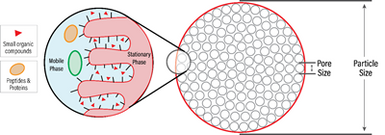Posted by Chrom Tech on 14th Oct 2025
Pore Size vs. Particle Size in HPLC Columns
Selecting the right HPLC column is crucial for achieving precise, reproducible chromatographic results. Chemical factors such as stationary phase type and pore size influence selectivity and retention, while physical parameters like particle size, column length, and inner diameter determine efficiency, backpressure, and analysis speed.

Understanding Pore Size
Pore size defines the average size of pores in the column’s stationary phase particles, typically measured in angstroms (Å). The pore size directly affects molecular accessibility and surface interaction. Choosing an appropriate pore size ensures efficient diffusion and resolution for analytes of different molecular weights.
| Analyte Type | Typical MW | Recommended Pore Size (Å) |
|---|---|---|
| Small molecules | ≤ 2,000 | 80–120 |
| Peptides / Proteins | 2,000–100,000 | 200–450 |
| Large proteins / Vaccines | >100,000 | 1,000–4,000 |
For GPC/SEC separations, always match the column’s pore size to your sample’s molecular weight distribution for optimal resolution. Explore InfinityLab Poroshell 120 Columns for reliable performance.

Understanding Particle Size
Particle size describes the diameter of the stationary phase particles packed inside the column. A narrow particle size distribution improves reproducibility, efficiency, and peak symmetry.
Common Particle Sizes and Applications
- 5 µm: Traditional analytical HPLC applications
- 3.5 µm: Method development and routine QC analysis
- Sub-2 µm: High-speed, high-resolution UHPLC separations
Performance Relationships
- Halving particle size doubles theoretical plates (efficiency)
- Halving particle size increases backpressure fourfold
- Superficially porous particles (SPP) offer sub-2 µm performance with significantly reduced backpressure—ideal for conventional HPLC systems.

Column Length Considerations
- Doubling column length doubles both plate count and analysis time.
- Backpressure increases proportionally with column length.
Example: A 2.1 × 100 mm column packed with 3.5 µm particles yields ~13,000 plates. Switching to 1.8 µm doubles efficiency but quadruples pressure. Reducing the length to 50 mm halves run time while maintaining efficiency with higher backpressure.
Selecting Column Inner Diameter (ID)
The inner diameter (ID) affects sensitivity, solvent consumption, and compatibility with detector type. Narrower columns require less solvent and enhance sensitivity—ideal for LC-MS workflows.
| Column ID | Recommended Use | Benefits |
|---|---|---|
| 2.1 mm | Mass spectrometry & low-flow analysis | High sensitivity, reduced solvent cost |
| 3.0–4.6 mm | Standard analytical HPLC | Balanced throughput and robustness |
| > 4.6 mm | Preparative chromatography | High loading capacity, faster flow |
Quick Reference: Column Selection Guidelines
| Goal | Recommended Setup |
|---|---|
| High Throughput | Short columns with sub-2 µm particles |
| Complex Separations | Longer columns, small particles, high pressure |
| LC-MS Sensitivity | 2.1 mm ID columns, reduced flow rates |
| Preparative Scale | Larger ID (≥ 10 mm), 5–10 µm particles |
Conclusion
Selecting an HPLC column involves balancing particle size, pore size, column length, and inner diameter to meet specific analytical goals. Whether optimizing throughput, resolution, or sensitivity, understanding these parameters ensures reliable, reproducible chromatographic results. For personalized guidance or to source authentic Agilent and Chrom Tech columns, visit our HPLC Accessories page.
Frequently Asked Questions
What factors influence HPLC column performance?
Column performance depends on stationary phase chemistry, particle size, pore size, and operating conditions like flow rate and temperature.
How does particle size affect resolution and backpressure?
Smaller particles increase resolution by producing more theoretical plates but also raise backpressure; SPP columns offer high efficiency with lower resistance.
Why choose narrow-bore (2.1 mm ID) columns?
Narrow-bore columns reduce solvent consumption, enhance MS sensitivity, and maintain high efficiency with compatible low-flow LC systems.
When should I use large-ID preparative columns?
Use large-diameter columns (≥10 mm) with larger particle sizes (5–10 µm) for high-load preparative purification and compound isolation.

